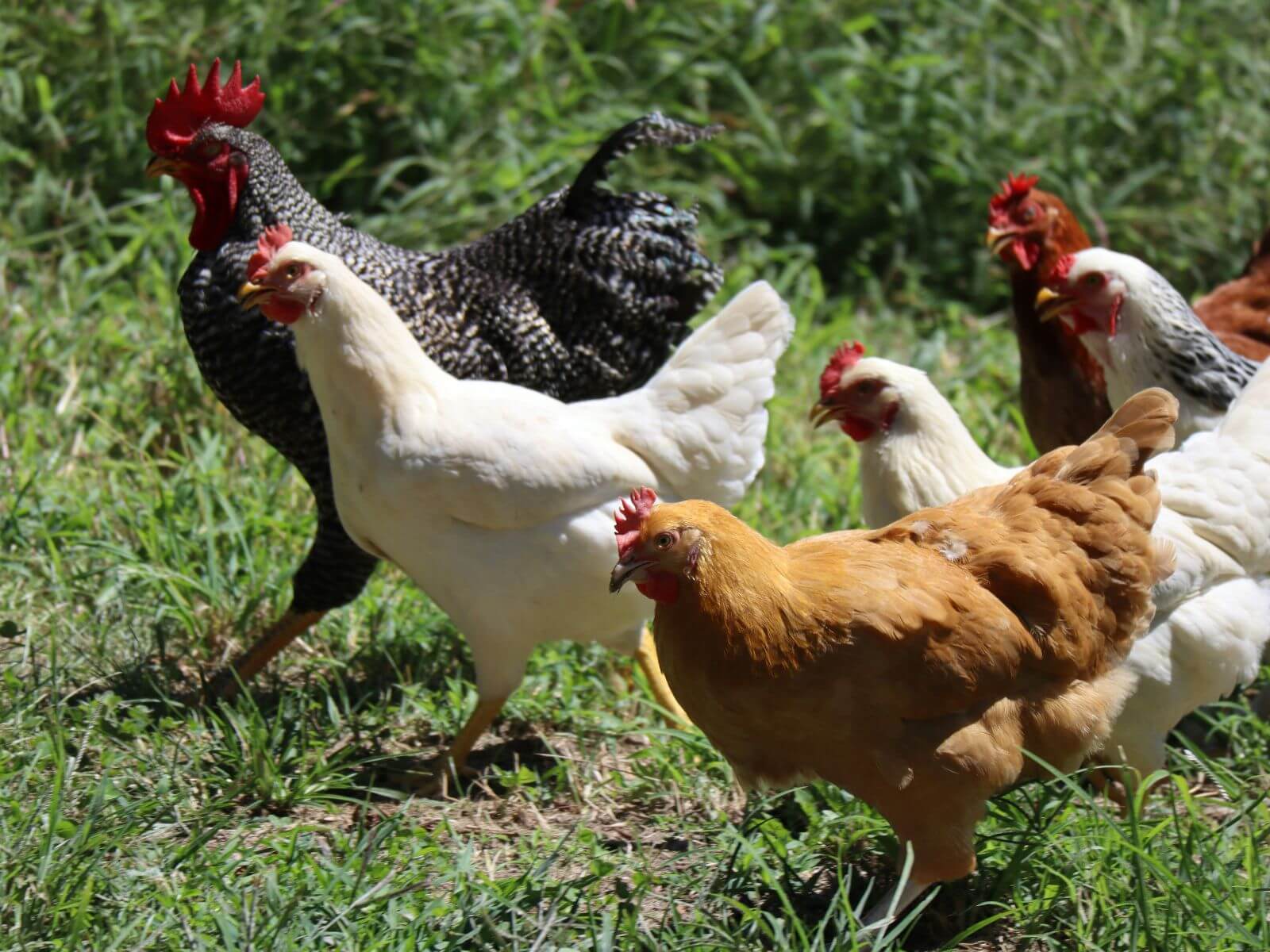Table of Contents
Chicken Vocabulary: Terms Every Chicken Owner Should Know
In this guide, we’ll explore the key aspects of chicken anatomy and health that every chicken owner should understand to ensure the well-being of their flock. From physical features to internal organs, we’ll cover common issues that can arise in these areas. Whether you're a new or experienced chicken keeper, this guide will help you identify potential problems and keep your chickens happy and healthy. If you ever have concerns about your chickens' health, always consult a veterinarian for expert advice and care.
Essential Chicken Anatomy
*This diagram provides a simplified overview of chicken anatomy for general understanding. It is not to scale and may not include all anatomical features.
Let’s begin with some key chicken vocabulary: simple chicken anatomy. Our simplified graphic provides an overview of the most important chicken features that every owner should be familiar with. These include the comb, waddle, crop, and vent—vital parts of your chicken’s body that contribute to their overall health and comfort.
- Comb: The fleshy, crown-like structure located on top of a chicken's head. It plays a vital role in regulating body temperature and varies in size and shape depending on the chicken’s breed and sex.
- Waddle: The fleshy, hanging skin beneath a chicken's beak. It assists in temperature regulation and serves as an indicator of a hen's health and age.
- Crop: A part of the chicken’s digestive system that stores food before it enters the stomach. A properly functioning crop is essential for efficient digestion.
- Vent: The opening located near the base of the tail, responsible for the chicken’s reproductive, urinary, and digestive functions.
Common Health Issues to Watch For
Each of the essential parts of your chicken’s body is susceptible to specific health issues. Understanding the following chicken vocabulary will help you ensure your chickens stay healthy and comfortable. Here are common issues associated with the anatomy we’ve discussed:
- Waddle Problems: Although the waddle helps with temperature regulation and is a sign of health, it can become infected or injured. Swelling, redness, or unusual discharge from the waddle may signal an infection or irritation. If your hen's waddle changes in size or appearance, particularly in older birds, it’s best to consult a vet.
- Comb Problems: A healthy comb is bright red, signaling that the chicken is in good health. If the comb appears pale, discolored, or shriveled, it may indicate stress, poor nutrition, or illness. Frostbite on the comb is also common in colder weather, leading to darkened, damaged tissue. Keeping your chickens in a warm, dry environment and ensuring proper nutrition can help prevent these issues.
- Vent Infections: The vent serves several important functions and can become prone to infections. Vent gleet, a fungal infection, is one of the most common issues and can cause swelling, discharge, and irritation. If you notice your chicken’s vent is inflamed or has a foul odor, it’s crucial to isolate the affected bird and seek veterinary care to prevent the infection from spreading.
- Sour Crop/Impacted Crop: The crop stores food before it enters the stomach. However, when it becomes blocked or impacted with undigested food, it can cause discomfort and even lead to more serious health concerns. Symptoms of an impacted crop include a swollen crop that doesn’t empty overnight, lethargy, and loss of appetite. If left untreated, it can cause infection or gastrointestinal issues. Consult a vet if you suspect your chicken is crop-bound for proper treatment.
Regularly checking these areas and monitoring your chickens’ health can help you catch potential issues early. If you notice any concerning symptoms, don’t hesitate to reach out to a vet to ensure your flock stays healthy and happy.
Other Common Chicken Terms Every Owner Should Know
As a chicken owner, it’s important to expand your vocabulary beyond basic anatomy and health terms. Knowing additional terms related to chicken behavior and development will further help you manage your flock and care for your chickens. Below are other common terms that every chicken keeper should be familiar with:
Molting: Molting is the natural process where chickens shed old feathers and grow new ones, typically during the fall or winter months. During molting, you may notice a temporary decrease in egg production, as hens focus their energy on regrowing feathers. While molting is a sign of a healthy chicken, it can be a stressful time. Be patient and provide extra protein and calcium to support feather regrowth. If excessive feather loss or other health issues occur, consult a veterinarian to rule out other concerns.
Candling: Candling is a technique used to assess the development and fertility of eggs. By shining a light through an egg, you can observe its contents to check for signs of embryo development or abnormalities. Candling is typically done about a week into the incubation period and is a helpful tool for breeders to confirm fertility. Be sure to handle eggs gently to avoid disturbing the incubation process.
Broody: A broody hen exhibits the instinct to sit on her eggs in order to hatch them. During this time, she may stop laying eggs and become more territorial and protective. Broody behavior can be beneficial for breeding, but it can also interfere with egg production. If you don’t want your hen to hatch eggs, you can manage her broody behavior by isolating her or using a "broody buster" technique to break the cycle.
Pullet: A pullet is a young female chicken, typically under one year of age, that has not yet started laying eggs. As pullets approach one year of age, they begin to mature and start laying eggs, signaling the transition to adulthood. Understanding the difference between pullets and adult hens is important for managing your flock, as pullets require special care and attention during their growth phase.
By understanding some chicken vocabulary, you’ll be well-equipped to care for your flock and address any health or behavioral concerns that may arise. Whether you're keeping an eye out for signs of molting, monitoring egg development through candling, or managing a broody hen, this knowledge will make you a more confident and effective chicken keeper. Always remember, when in doubt, consult with a veterinarian to ensure the best possible care for your chickens. With a little knowledge and attention, your flock will thrive and remain healthy for years to come.
FAQs
What are the key chicken terms every owner should know?
Here’s a quick guide to the most important chicken terms every owner should be familiar with:
- Comb: The fleshy crown on top of a chicken's head that helps with temperature regulation.
- Waddle: The fleshy skin under a chicken’s beak, which helps regulate temperature and indicates a hen’s health and age.
- Crop: The part of the chicken's digestive system that stores food before it enters the stomach.
- Vent: The opening near the base of the tail used for reproductive, urinary, and digestive functions.
- Molting: The natural process where chickens shed old feathers and grow new ones.
- Candling: A method used to check the fertility and development of eggs by shining a light through them.
- Broody: A hen that sits on her eggs to incubate them, often stopping egg-laying during this time.
- Pullet: A young female chicken, typically under one year of age, that hasn’t started laying eggs yet.
How can I tell if my chicken's crop is impacted?
If your chicken’s crop is swollen and doesn't empty overnight, it could be impacted. Other signs include lethargy and loss of appetite. If you suspect an impacted crop, gently massage the area and consult a vet for treatment, which may include medication or manual removal of the blockage.
What should I do if my chicken’s vent appears swollen or has discharge?
A swollen or discharge-filled vent could be a sign of vent gleet, a fungal infection. It’s essential to isolate the affected chicken to prevent the infection from spreading and seek veterinary care for appropriate treatment. Good hygiene in their living space will also help reduce the risk of infections.
How can I tell the difference between a pullet and a hen?
A pullet is a young female chicken, typically under one year of age, that has not started laying eggs yet. Once she begins laying, she transitions into adulthood and becomes a hen. Pullets need more care during their growth phase, so it’s essential to provide them with proper nutrition and environment to support their development.









